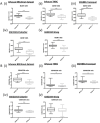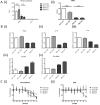A BRCA1 deficient, NFκB driven immune signal predicts good outcome in triple negative breast cancer
- PMID: 26943587
- PMCID: PMC4991425
- DOI: 10.18632/oncotarget.7865
A BRCA1 deficient, NFκB driven immune signal predicts good outcome in triple negative breast cancer
Abstract
Triple negative (TNBCs) and the closely related Basal-like (BLBCs) breast cancers are a loosely defined collection of cancers with poor clinical outcomes. Both show strong similarities with BRCA1-mutant breast cancers and BRCA1 dysfunction, or 'BRCAness', is observed in a large proportion of sporadic BLBCs. BRCA1 expression and function has been shown in vitro to modulate responses to radiation and chemotherapy. Exploitation of this knowledge in the treatment of BRCA1-mutant patients has had varying degrees of success. This reflects the significant problem of accurately detecting those patients with BRCA1 dysfunction. Moreover, not all BRCA1 mutations/loss of function result in the same histology/pathology or indeed have similar effects in modulating therapeutic responses. Given the poor clinical outcomes and lack of targeted therapy for these subtypes, a better understanding of the biology underlying these diseases is required in order to develop novel therapeutic strategies.We have discovered a consistent NFκB hyperactivity associated with BRCA1 dysfunction as a consequence of increased Reactive Oxygen Species (ROS). This biology is found in a subset of BRCA1-mutant and triple negative breast cancer cases and confers good outcome. The increased NFκB signalling results in an anti-tumour microenvironment which may allow CD8+ cytotoxic T cells to suppress tumour progression. However, tumours lacking this NFκB-driven biology have a more tumour-promoting environment and so are associated with poorer prognosis. Tumour-derived gene expression data and cell line models imply that these tumours may benefit from alternative treatment strategies such as reprogramming the microenvironment and targeting the IGF and AR signalling pathways.
Keywords: BRCA1; NFkB; microenvironment; predictive biomarker; triple negative breast cancer.
Conflict of interest statement
The authors declare no conflict of interest
Figures





Similar articles
-
Increased ID4 expression, accompanied by mutant p53 accumulation and loss of BRCA1/2 proteins in triple-negative breast cancer, adversely affects survival.Histopathology. 2016 Apr;68(5):702-12. doi: 10.1111/his.12801. Epub 2015 Nov 2. Histopathology. 2016. PMID: 26259780
-
BRCA1-IRIS inactivation overcomes paclitaxel resistance in triple negative breast cancers.Breast Cancer Res. 2015 Jan 13;17(1):5. doi: 10.1186/s13058-014-0512-9. Breast Cancer Res. 2015. PMID: 25583261 Free PMC article.
-
Identification of BRCA1-like triple-negative breast cancers by quantitative multiplex-ligation-dependent probe amplification (MLPA) analysis of BRCA1-associated chromosomal regions: a validation study.BMC Cancer. 2016 Oct 19;16(1):811. doi: 10.1186/s12885-016-2848-2. BMC Cancer. 2016. PMID: 27756336 Free PMC article.
-
BRACking news on triple-negative/basal-like breast cancers: how BRCA1 deficiency may result in the development of a selective tumor subtype.Cancer Metastasis Rev. 2012 Jun;31(1-2):131-42. doi: 10.1007/s10555-011-9336-6. Cancer Metastasis Rev. 2012. PMID: 22101651 Review.
-
The cell of origin of BRCA1 mutation-associated breast cancer: a cautionary tale of gene expression profiling.J Mammary Gland Biol Neoplasia. 2011 Apr;16(1):51-5. doi: 10.1007/s10911-011-9202-8. Epub 2011 Feb 19. J Mammary Gland Biol Neoplasia. 2011. PMID: 21336547 Review.
Cited by
-
Dual Mechanisms of LYN Kinase Dysregulation Drive Aggressive Behavior in Breast Cancer Cells.Cell Rep. 2018 Dec 26;25(13):3674-3692.e10. doi: 10.1016/j.celrep.2018.11.103. Cell Rep. 2018. PMID: 30590041 Free PMC article.
-
Automated Tumour Recognition and Digital Pathology Scoring Unravels New Role for PD-L1 in Predicting Good Outcome in ER-/HER2+ Breast Cancer.J Oncol. 2018 Dec 17;2018:2937012. doi: 10.1155/2018/2937012. eCollection 2018. J Oncol. 2018. PMID: 30651729 Free PMC article.
-
Prognositic significance of P-cadherin expression in breast cancer: Protocol for a meta-analysis.Medicine (Baltimore). 2019 Mar;98(12):e14924. doi: 10.1097/MD.0000000000014924. Medicine (Baltimore). 2019. PMID: 30896652 Free PMC article.
-
Interleukin-34 cancels anti-tumor immunity by PARP inhibitor.J Gynecol Oncol. 2023 May;34(3):e25. doi: 10.3802/jgo.2023.34.e25. Epub 2022 Dec 21. J Gynecol Oncol. 2023. PMID: 36603850 Free PMC article.
-
Targeting NFκB signaling in GD2+ BCSCs.Aging (Albany NY). 2017 Aug 3;9(8):1847-1848. doi: 10.18632/aging.101274. Aging (Albany NY). 2017. PMID: 28858852 Free PMC article. No abstract available.
References
-
- Sorlie T, Perou CM, Tibshirani R, Aas T, Geisler S, Johnsen H, Hastie T, Eisen MB, van de Rijn M, Jeffrey SS, Thorsen T, Quist H, Matese JC, Brown PO, Botstein D, Eystein Lonning P, et al. Gene expression patterns of breast carcinomas distinguish tumor subclasses with clinical implications. PNAS. 2001;98:10869–10874. - PMC - PubMed
-
- Bertucci F, Finetti P, Cervera N, Esterni B, Hermitte F, Viens P, Birnbaum D. How basal are triple-negative breast cancers? Int J Cancer. 2008;123:236–240. - PubMed
-
- Yang Q, Sakurai T, Mori I, Yoshimura G, Nakamura M, Nakamura Y, Suzuma T, Tamaki T, Umemura T, Kakudo K. Prognostic significance of BRCA1 expression in Japanese sporadic breast carcinomas. Cancer. 2001;92:54–60. - PubMed
-
- Turner N, Tutt A, Ashworth A. Hallmarks of ‘BRCAness’ in sporadic cancers. Nat Rev Cancer. 2004;4:814–819. - PubMed
-
- Abbott DW, Thompson ME, Robinson-Benion C, Tomlinson G, Jensen RA, Holt JT. BRCA1 expression restores radiation resistance in BRCA1-defective cancer cells through enhancement of transcription-coupled DNA repair. J Biol Chem. 1999;274:18808–18812. - PubMed
MeSH terms
Substances
LinkOut - more resources
Full Text Sources
Other Literature Sources
Research Materials
Miscellaneous

